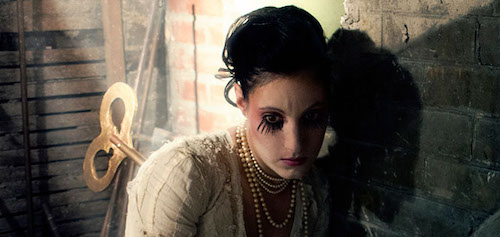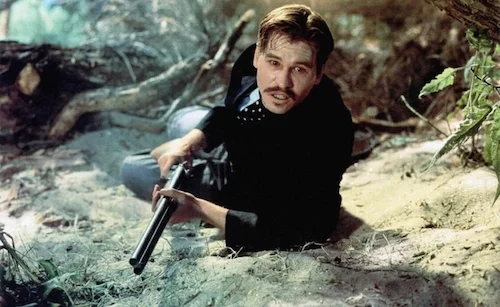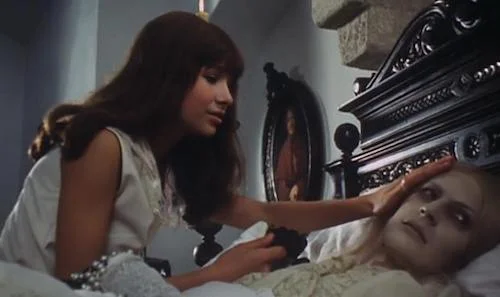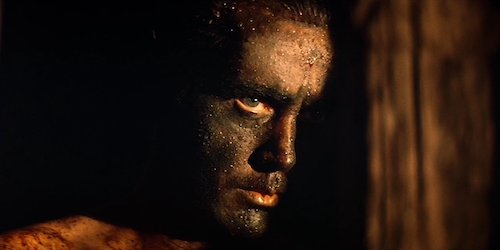Kate Mior: Channelling Cinematic Performances Off-Screen
Today we are highlighting a street performer that highlights many joys of the cinematic language, despite not actually directly-relating to film in any way. Kate Mior brings to life wind up toys, potraits, and statues, all through her fantastic mime work. Her comedy resembles the familiar faces of the silent film era, but her aesthetic is very golden-age of Hollywood. I’ve managed to watch Mior’s Marie Antoinette act in Toronto, where she invites audience members on stage to face their own execution (seriously: there’s a guillotine and everything). Title cards are held up (once again, evoking the atmosphere of the silent age) that preface each part of her set, whether an audience member is to eat cake (or whipped cream) with the late Queen or engage in a fight for their lives (with a limp baguette as their only possible weapon). The elite gets satirized. The crowd gets involved. Not a word is spoken.
Mior has attracted the likes of many, including filmmakers (respect from Guillermo Del Toro is always a great anecdote for a resume). She has toured around the world with her acts for a number of years. Where does all of this cinematic influence come from? Mior’s background, of course. Mior studied film at Ryerson University, with a focus on animation. She has been a part of festival circuits (including TIFF). One day, she made the full transition into street performing and never looked back. I was able to discuss this shift with Mior, and discuss why cinema still plays a prevalent role in her artistry today.
For information on Kate Mior’s past and current work, head over to her official website here.
Films Fatale: How did studying film help you with your street performances? Was there any influence that the cinematic language gave to your interpretations of life through art?
Kate Mior: When I studied film, I focused on animation, and actually studied mime to better understand movement, so I would definitely say the two are interdependent. Performing live and through a lens obviously have different requirements of the performer and a different relationship to the audience, but film language gave me the foundation to understand storytelling on it's most fundamental level, which is something I strive to bring into my street shows. I definitely take influence from cartoons in my work and try to bring things like squash and stretch to life.
FF: Why did you put filmmaking aside? Was it an easy decision?
KM: Actually, putting film aside was a very easy decision. By the time I was in my third year of university I was effectively performing full time and enjoyed it so much more. The film industry always felt too... inefficient for me, and, while I do enjoy collaborating with other artists, I've always felt a strong desire to work alone. I also viciously despise the hierarchical culture of set life.
FF: Are there any similarities in the competitivenesses between the busking community and the film industry?
KM: I don’t really see street performing as particularly competitive... maybe it’s because I've been doing it so long, or maybe it's because most professional street artists generally have a different attitude to the "work force pool": we are mobile workers and constantly travel to chase a living. If we don’t like, say, the politics or environment somewhere, we just go elsewhere. Film always just felt thirsty to me and I'm not interested in that.
FF: There are obvious differences in how audiences receive a story between seeing a film and a street performance. However, in your experiences, what are the similarities? Are there universal story-telling traits that transcend mediums?
KM: The biggest difference between a film and a street show is participation. Unlike watching a film passively, a street show doesn’t exist without its audience. However, we seem to be utilizing cinematic techniques more and more. I definitely am cognizant of things like staging, drama etc
Recently, my colleagues and I began to focus on "picture moments": a trick, or a visual moment in the show that would make a great takeaway photo or video for our audience. In North America and Asia especially, there is a lot more photography now than ever before so we are adapting and growing.
FF: On that note, have you had a favourite place you have performed in?
KM: Favourite place is relative... it's never about the place but about the memories attached to it, or an experience that was unforgettable. Doing a hard street show in Freetown Sierra Leone was definitely a highlight, but I also have so many memories of amazing shows or experiences in Edinburgh; one of my favourites was doing an evening show at the Grassmarket on the exact spot public executions used to occur (my show is a public execution).
FF: With that in mind, do you have a favourite act you like to perform?
KM: [The] favourite act for me is probably the cake eating routine because it's the "loosest" act where anything can really happen. Or the crowd build part of my show because I can fuck around and do whatever I want. I have a bit I call my "Buffalo Build" where I play Q Lazzarus and just say stupid shit into the mic. Those who get the jokes and reference end up being the best audience. I love being able to curate my audiences.
FF: We like to send interviews off with the most basic question, based on why we are all cinephiles. What are your top five films of all time, and why?
Tombstone
KM: Partly because it left such a profound impact on me as kid, I truly do believe street performers are the modern day equivalent to old west gamblers. That film is fun, interestingly placed, and a great example of a well-executed ensemble cast (and yes its a guilty pleasure film).
Valerie and Her Week of Wonders
KM: Brilliant Czech film with amazing visual imagery about a young girl who experiences her first foray into adulthood. Its irreverent, dark, surrealist and insane.
Street of Crocodiles
KM: I was a student of stop motion animation and I collect all kinds of Victorian ephemera (mourning jewelry, corsets, I even have a Victorian wheelchair in my possession) so obviously when I first saw this surreal masterpiece in high school it completely informed my visual aesthetic (even if at first glance you don’t see it) and left a huge impression.
The Man Who Fell to Earth
KM: Gorgeous soundtrack, beautiful story, contemplative and a fantastic message. I love this film because of how it always makes me feel residually weeks later.
Apocalypse Now (Redux)
KM: Perfect balance of dread, insanity, brutality. One of my guilty pleasures on tour when I'm in Asia is to sit on my balcony after shows at night listening to the Doors and drinking. I mean, if you haven’t drunkenly danced half naked in your hotel room in China while listening to The End have you truly lived?
Films Fatale thanks Kate Mior for her time. Check out her latest shows, and all of her past works on her website here.
Andreas Babiolakis has a Masters degree in Film and Photography Preservation and Collections management from Ryerson University, as well as a Bachelors degree in Cinema Studies from York University. His favourite times of year are the Criterion Collection flash sales and the annual Toronto International Film Festival.









